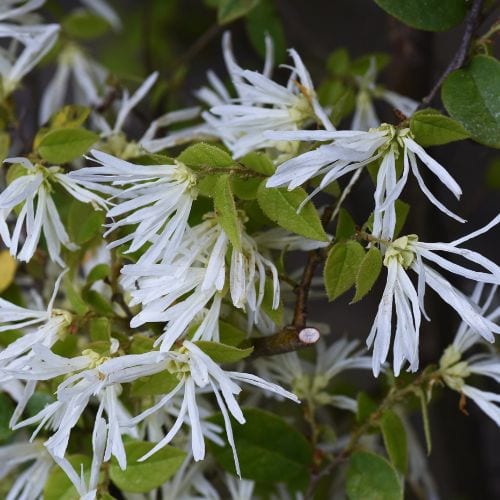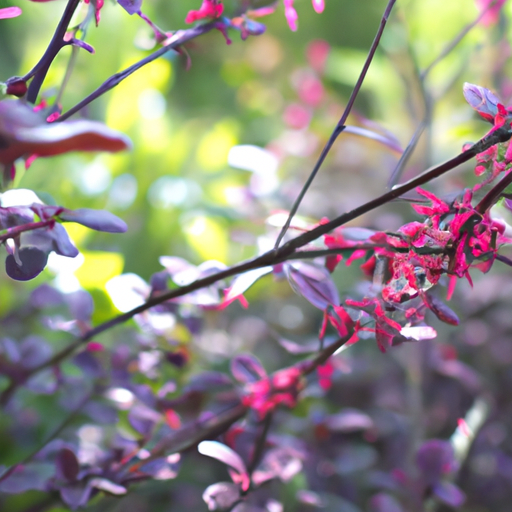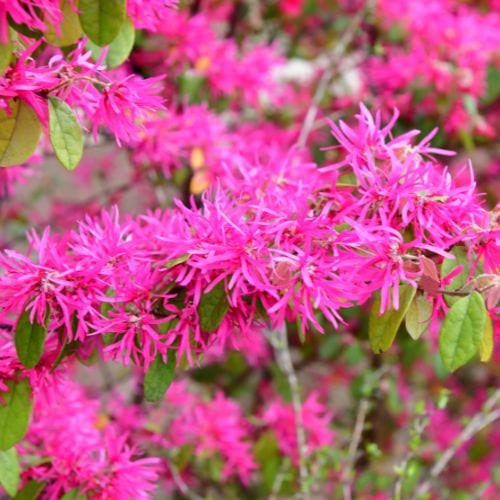Table of Contents
How to Care for Loropetalum in Different Climates
Loropetalum care is super-easy because these are hardy shrubs that thrive in USDA Zones 7-10. If you’re looking for a beautiful shrub to add to your garden, Loropetalum is a great choice! This evergreen shrub is native to China, Japan, and parts of the Himalayas. It’s known for its stunning foliage and vibrant flowers. But, depending on where you live, you’ll need to take different steps to ensure your Loropetalum stays healthy and happy year-round. Here’s how to care for Loropetalum in different climate zones throughout the US.
In warmer climates, Loropetalum will thrive in full sun or partial shade. Make sure to water your Loropetalum regularly, especially during the summer months. You’ll also want to fertilize your Loropetalum every few months to ensure it gets the nutrients it needs.
In cooler climates, Loropetalum will need more protection from the cold. Plant your Loropetalum in a sheltered spot, such as near a wall or fence, to protect it from strong winds. You’ll also want to mulch around the base of the shrub to help keep the soil moist and warm.
No matter what climate you live in, it’s important to prune your Loropetalum regularly. Pruning will help keep your shrub healthy and encourage new growth. You can prune your Loropetalum in the spring or summer, but make sure to avoid pruning in the fall or winter.
Caring for Loropetalum in different climates may require a few extra steps, but it’s worth it for the beautiful blooms and lush foliage this shrub provides. With the right care, your Loropetalum will be a stunning addition to your garden for years to come!

The Benefits of Adding Loropetalum to Your Landscape
Are you looking for a unique and eye-catching addition to your landscape? If so, definitely consider adding loropetalum to your garden. This evergreen shrub is known for its vibrant foliage and fragrant flowers. Here are some of the benefits of adding loropetalum to your landscape for those of you who haven’t already.
First, loropetalum is an incredibly versatile shrub. It can be used as a hedge, a border, or even as a specimen plant. It can also be pruned into a variety of shapes, making it a great choice for topiary. Plus, it’s easy to care for and requires minimal maintenance.
Second, loropetalum is a great choice for adding color to your landscape. Its foliage is a deep burgundy color that stands out against other plants. In the spring, it produces clusters of pink flowers that add even more color to your garden.
Third, loropetalum is drought-tolerant and can thrive in a variety of soil types once established. It’s also resistant to pests and diseases, making it a great choice for low-maintenance landscaping.
Finally, loropetalum is a great choice for attracting wildlife to your garden. Its fragrant flowers attract butterflies and hummingbirds, while its berries provide food for birds.
As you can see, there are many benefits to adding loropetalum to your landscape. Its vibrant foliage and fragrant flowers will add color and interest to your garden, while its low-maintenance requirements make it a great choice for busy gardeners. So, if you’re looking for a unique and eye-catching addition to your landscape, consider adding loropetalum to your garden today! Next up, we’ll look at how you can plant yours for gardening success.
Tips for Planting Loropetalum in Your Garden

1. Choose a location with well-draining soil and full sun to partial shade. Loropetalum plants prefer a slightly acidic soil, so if your soil is alkaline, you may want to add some sulfur to lower the pH.
2. Dig a hole twice as wide as the root ball of your Loropetalum and just as deep. If you are planting multiple Loropetalums, space them at least 3 feet apart.
3. Place the root ball in the hole and fill in with soil. Make sure the top of the root ball is level with the soil surface.
4. Water your Loropetalum thoroughly after planting.
5. Mulch around the base of the plant to help retain moisture and keep weeds away.
6. Prune your Loropetalum in late winter or early spring to maintain its shape and encourage new growth.
7. Fertilize your Loropetalum in early spring with a balanced fertilizer.
8. Monitor your Loropetalum for signs of pests or disease and treat accordingly.
Following these tips will help ensure your Loropetalum thrives in your garden! And if you haven’t bought yours yet, order them today on Amazon by clicking on the image below:
How to Prune Loropetalum for Maximum Blooms
If you want to get the most blooms out of your Loropetalum shrub, pruning is key! Pruning your Loropetalum will help it stay healthy and encourage more blooms. Here’s how to do it:
1. Start pruning in late winter or early spring. This is the best time to prune your Loropetalum because it will help encourage new growth and blooms.
2. Prune off any dead or damaged branches. This will help keep your Loropetalum healthy and encourage new growth.
3. Prune off any branches that are growing in an undesirable direction. This will help keep your Loropetalum looking neat and tidy.
4. Prune off any branches that are crossing over each other. This will help keep your Loropetalum from becoming too crowded and will help encourage more blooms.
5. Prune off any branches that are too long or too low. This will help keep your Loropetalum looking neat and will help encourage more blooms.
6. Prune off any branches that are growing too close to the ground. This will help keep your Loropetalum from becoming too crowded and will help encourage more blooms.
7. Prune off any branches that are growing too close to other plants. This will help keep your Loropetalum from becoming too crowded and will help encourage more blooms.
By following these steps, you can help your Loropetalum stay healthy and you’ll encourage more blooms. Pruning your Loropetalum is an important part of keeping it healthy and looking its best.
Winter Care For Loropetalum
Winter care for Loropetalum is relatively easy. This evergreen shrub is hardy in USDA zones 7-10, so if you live in a colder climate, you may need to take extra precautions to protect your Loropetalum from the cold. Planting yours right next to your home’s exterior might provide some radiant heat and help protect them from the coldest weather in your area. Here’s a few more tips for helping your Loropetalum shrubs survive the cold.
First, make sure your Loropetalum is planted in a spot that gets plenty of sunlight. This will help it stay healthy and strong throughout the winter months.
Second, mulch your Loropetalum with a thick layer of organic material. This will help insulate the roots and keep them from freezing.
Third, water your Loropetalum regularly throughout the winter. This will help keep the soil moist and prevent the roots from drying out.
Fourth, if you live in a colder climate, you may want to consider wrapping your Loropetalum in burlap or other protective material when temperatures dip down to extremely cold levels overnight. This will help protect it from the cold and wind.
Finally, prune your Loropetalum in late winter or early spring. This will help keep it healthy and encourage new growth to sustain it through to the next year.
With a little extra care, your Loropetalum will thrive throughout the winter months in USDA hardiness zones 7-10.

Watering Loropetalum
Watering your Loropetalum is an important part of keeping it healthy and looking its best. The amount of water your Loropetalum needs will depend on the climate you live in and the time of year. In general, Loropetalum should be watered deeply and infrequently.
In warmer climates, Loropetalum should be watered once a week during the summer months. During the winter, water your Loropetalum every two to three weeks. In cooler climates, you may need to water your Loropetalum more often during the summer months.
When watering your Loropetalum, make sure to water it deeply. This means that you should water it until the soil is saturated and water is running out of the bottom of the pot. This will ensure that the roots of your Loropetalum are getting enough water.
It’s also important to make sure that your Loropetalum is not getting too much water. Overwatering can cause root rot and other problems. To avoid this, make sure that the soil is allowed to dry out slightly between waterings.
Finally, make sure to check the soil of your Loropetalum before watering. If the soil is still moist, then you don’t need to water it. This will help you avoid overwatering and keep your Loropetalum healthy.
Fertilizing Loropetalum
Fertilizing your Loropetalum is an important part of keeping it healthy and looking its best. Loropetalum is a beautiful evergreen shrub that produces vibrant pink or white flowers in the spring and summer. It’s a great addition to any garden, but it does need regular fertilizing to stay healthy.
The best time to fertilize your Loropetalum is in the spring, just before new growth begins. You can use a slow-release fertilizer or a liquid fertilizer. If you choose a slow-release fertilizer, make sure to follow the instructions on the package. If you choose a liquid fertilizer, mix it with water according to the instructions on the package and apply it to the soil around the base of the plant.
It’s important to fertilize your Loropetalum regularly. You should fertilize it every four to six weeks during the growing season. This will help keep it healthy and encourage new growth.
When fertilizing your Loropetalum, make sure to avoid getting the fertilizer on the leaves. This can cause leaf burn and damage the plant. Also, be sure to water the plant after fertilizing to help the fertilizer reach the roots. Take care not to overfeed with chemical fertilizers, as this can cause damage to the plant.
Fertilizing your Loropetalum is an important part of keeping it healthy and looking its best. With regular fertilizing, you can enjoy its vibrant flowers and lush foliage for years to come.



